Posts Tagged ‘Blue Mountains Significant Tree Register’
Friday, June 2nd, 2023
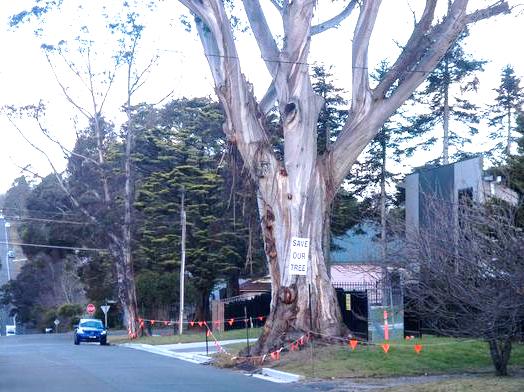 ‘ATLAS’? This is the worthy name our campaign branded this magnificent and extremely rare 250+ year-old Eucalyptus oreades that came under greedy developer threat. It is an endemic native tree estimated to predate Katoomba and indeed pre-date Captain Cook (that is pre-1770!)
About ‘Friends of ATLAS’
Back in 2014 at the start of spring in the Blue Mountains (Australia), Katoomba residents Maureen and Peter Toy from their home at 57 Megalong Street observed a man inspecting this magnificent tree on the verge out front. They approached the man, who then told them that he reckoned the tree was “diseased” and so had to be “removed” (aka killed).
The Toy’s campaign to save this magnificent tree was on in earnest!
ATLAS survives in good health, not diseased, as a 250 year old (in 2014) native Blue Mountains Ash (Eucalyptus oreades), with a still-growing canopy of 40+ metres high.
ATLAS pre-dates the settlement of Katoomba. Indeed, ATLAS predates colonial settlement of Australian in 1788. According to a learned Grade 5 arborist with long experience in these species, ATLAS probably started growing as a sapling from the 1760s – before the French Revolution, before the American War of Independence, before James Cook first set sail from Britain to explore the Pacific and find the rumoured great southern continent in 1768.
This tree is an icon like the Three Sisters, yet hidden in Blue Mountains {city} Council’s assigned industrial area of Katoomba near the headwaters of Leura Creek and upstream of the popular tourist attraction of Leura Cascades and Leura Falls which tumbles into the Jamison Valley within the Greater Blue Mountains World Heritage Area.
According to advice the Toys received from local conservation consultancy The Habitat Advocate, this large Blue Mountains Ash (Eucalyptus oreades) is a native tree only found in the Upper Blue Mountains. Thousands of oreades were incinerated by the 2003 Centennial Glen bushfire, making the species now threatened in the upper Blue Mountains.
Maureen says:
“It is a beautiful and rare specimen and Blue Mountains folk are fortunate that we have such a significant tree still growing right by Megalong Street in industrial Katoomba. Over the many decades, this tree has withstood fierce windstorms, bushfires, (dodgy) road-widening and even industrial development all around it.”
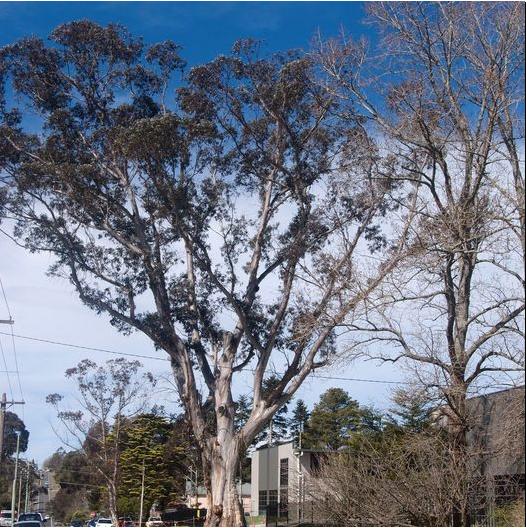 A new industrial development in 2014 was constructed behind ATLAS, replacing a old motor garage.
With a canopy about 40 metres high and a trunk girth of over 5 metres (measured at 1.4m above the ground ^SOURCE), the tree has become a recognised icon and reference point in the area. It is home to a large flock of Sulphur-Crested Cockatoos that roosts in the tree daily.
Campaign Background
Some years prior in 2012, The Habitat Advocate’s Conservation Consultant Steven, had had his own concerns about the new development taking place behind the tree at 59 Megalong Street Katoomba, and decided to take some before-shot photos; the following three taken on 11th January 2012.
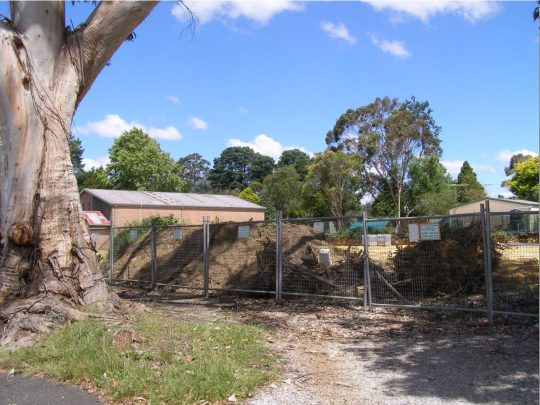

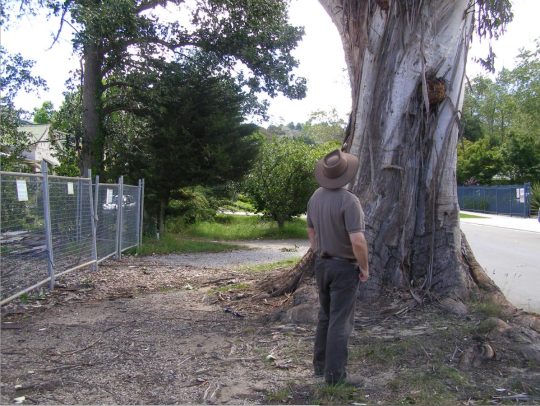 Our editor by ATLAS in 2012
So two years hence, with the new ‘mega industrial park’ constructed adjacent to the tree, the consulting arborist David Ford, whom Maureen and Peter had talked to, became the arch enemy to the preservation of the tree.
Peter couldn’t understand why the tree was NOT already listed on Council’s Blue Mountains Significant Tree Register or why anyone would want to harm it. The tree is situated on a community verge (Council-community land) and for the prior few years there had been an industrial development constructed behind it.
Peter and Maureen were vehemently opposed to any further harm being inflicted upon the tree and they have lodged a protest with council. Several others in the local community sided with the Toys and together formed an informal local community activist group ‘Friends of ATLAS’ – determined to save and protect this magnificent native tree. Their daughter Angelique started up an online petition to garner local community recognition and support to protect the tree.
Peter reckoned at the time:
“It’s early days but he is ready for a sustained fight.”
A fellow local supported commented:
“Dear Friends,
There is an emergency right now, to save one of the oldest Blue Mountain Ash trees that we have left.. The tree is now known as ‘Atlas’. You may well know this magnificent tree located at 59 Megalong Street, Katoomba. It has a girth of 5 metres and a growing canopy of 40 metres high. The tree has been estimated to be between 200 and 300 years old, I love this tree and hope you will help us save it 🙂
THANKS FOR YOUR SUPPORT
Peter H. Marshall”
A spokesperson from Blue Mountains {city} Council confirmed that the tree is situated on council verge land and not on the industrial development site behind. Research into the planning approval for the industrial development behind revealed that Council had stipulated in its development consent conditions that the tree must not be harmed by the development activity.
Though Peter disagrees. He says “guttering has been dug right into the tree roots system, then just a month ago the developer (behind) had a bobcat grade the topsoil and roots around the tree for an entire day!.”
Council’s spokesperson at the time clarified that council had not received any request for the tree to be destroyed. The community battle to save this tree from Council neglect and indifference was set to ensue.
Save ATLAS Campaign
The Habitat Advocate took a particular interest in saving this tree shortly after noticing the sign on it ‘SAVE OUR TREE‘, placed there by Peter and Maureen in September 2014.
Our Conservation Consultant, Steven, had first observed the sign on the tree whilst a driver for Blue Mountains Bus Company as he sat in a bus in the depot one morning doing his bus pre-checks.
After his shift, Steven took a chance that the sign’s maker lived nearby and so knocked on the door of the house adjacent at 57. Peter and Maureen opened the door and the contact was established. [Editor’s Note: Peter and Maureen have long since relocated back to their home town in Western Australia].
Steven suggested the tree deserved a name, as a brand for a public campaign to save it from being killed. Maureen affectionately called it the ‘Atlas’, after the Greek God, appropriately for its towering size and for be so enduring. In Greek mythology, Atlas was one of the most famous Titans, the son of Iapetus and the Oceanid Asia (or, possibly, Clymene). He was the leader of the Titan rebellion against Zeus, and he got a fitting punishment after the end of the Titanomachy: he was condemned to eternally hold up the sky. The etymology of the name ‘Atlas’ is from the ancient Greek word τλῆναι “to endure”.
This is a Roman statue of Atlas at the National Archaeological Museum of Naples in Italy. It is believed to be the oldest, dating from 2nd century AD.

Steven suggested a change of sign to generate more passerby interest, given that adjoining Megalong Street is a busy thoroughfare between the industrial precinct of Katoomba and Leura.
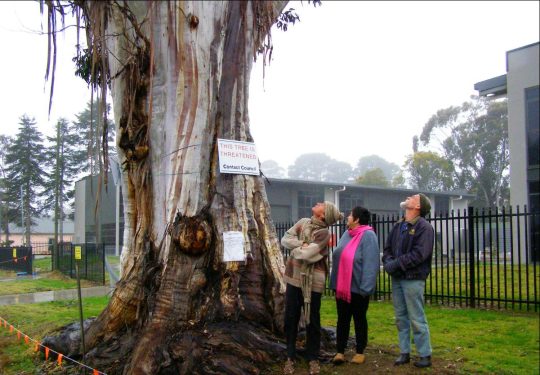 This new sign proved very effective. It reads: “THIS TREE IS THREATENED, Contact Council“. Many concerned locals indeed did contact Blue Mountains {city} Council to protest and demand what was going on. [Photo by Editor: Katoomba locals Maureen and Peter Toy, with Glenn Humphreys on the right, spring 2014]
“Threatened” was a play on words, since it had three meanings, intentionally.
Firstly, this flora species, a ‘Eucalyptus oreades’, is locally endemic to this small area of the Central Upper Blue Mountains, that is it is wildly found nowhere else on the planet and the species natural habitat and number of trees have been decimated by human deforestation since British colonisation of the area from the 1870s such that the remnant number of trees can almost be counted. This species and its ecological community is likely botanically deemed “threatened”, that is, it is likely to become extinct in the foreseeable future.
Secondly, this extremely large and mature, yet healthy specimen, could be more than 250 years old and so an even rarer example of the species. The number of such specimens growing in what once was their wild habitat may well be currently counted on one’s hands.
Thirdly, more imminent a threat is that the industrial developer who owns the site immediately behind this tree has intention of having it killed the tree in order to make way for some greedy notion of providing an overflow of customer parking on the verge outside his site.
Peter Toy quickly set up a dedicated Facebook Page (now defunct) in September 2014, calling it ‘Friends of ATLAS’. Maureen and Peter’s daughter Angelique established an online petition on the Change.org website.
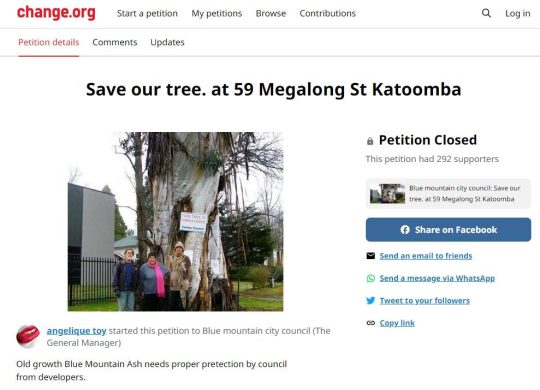 Garnering a community support base of nearly 300 individuals on a petition to save one important tree was one campaign success outcome
Fact Finding
As the publicity campaign to save the tree got under way, The Habitat Advocate considered some fact finding needed be done about the compliance of this development with Council’s conditions of consent, and in order to clarify the justification posed by the consulting arborist for killing this magnificent and otherwise healthy native tree.
Suspicions were that the arborist had assessed the tree on behalf of his client the property developer and had concluded what the developer wanted – the tree’s removal to make way for concrete paving of the Council verge to facilitate increased vehicle parking for the new industrial site.
Enquiries to Blue Mountains {city} Council confirmed that the development at 59 Megalong Street Katoomba was recorded by Council as ‘Industrial Development DA X/435/2010‘. A number of publicly available documents were obtained by The Habitat Advocate in relation to this development threat.
[Editor’s Note:
This habitat story is to be continued sometime in spring 2023, due to other pressing commitments that we currently have. The story shall be told in a number of parts discussing the SAVE ATLAS Campaign, its goals, strategy, opponents, supporters, relevant framework (planning and legal), research, publicity and ongoing updates. Unlike other attempts by Blue Mountains conservationists to save valued trees, especially endemic natives like this one, this conservation campaign succeeded and the campaign story shall provide not just a wonderful Blue Mountains story about a community coming together to protect natural heritage but also shall be instructive to others facing similar challenges of how to win against often overwhelming odds. Future parts to this story shall be posted in turn as a lead article on the front page of this website, The Habitat Advocate, which continues to be based in The Gully Catchment in the town of Katoomba since 2001. We thank our readers for their interest, support and patience].
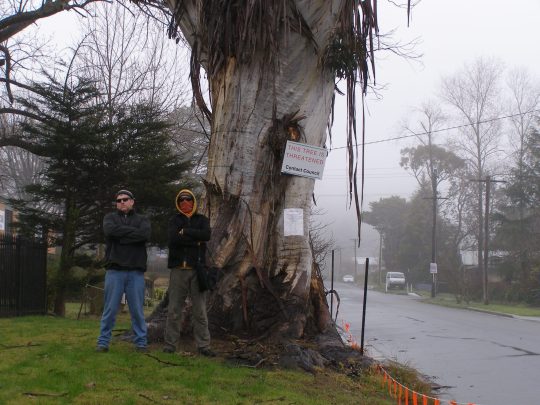 ATLAS Warriors
Further Reading:
[1] “Circumference is measured at 1.4 metres above ground level. If the tree forks, record the smallest circumference between 1.4m and the ground below the lowest fork“, National Register of Big Trees, ^https://www.nationalregisterofbigtrees.com.au/pages/tree-measurement
[2] ‘A Blue Mountains iconic tree at risk‘, 2012-10-10, ^https://habitatadvocate.com.au/a-blue-mountains-iconic-tree-at-risk/
[3]
[4]
Tuesday, March 6th, 2012
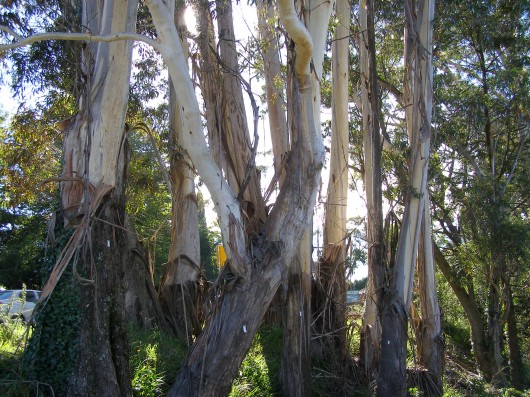 One of the few remaining clusters of mature Blue Mountains Ash (Eucalytus oreades)
endemic to the Upper Blue Mountains
[They are listed on BMCC’s Significant Tree Register
..including the dozen or so killed to widen the highway] One of the few remaining clusters of mature Blue Mountains Ash (Eucalytus oreades)
endemic to the Upper Blue Mountains
[They are listed on BMCC’s Significant Tree Register
..including the dozen or so killed to widen the highway]
.
What a steaming crock Blue Mountains Council’s (BMCC) Significant Tree Register is!
The 73 listed trees or listed tree communities on BMCC’s register listed as ‘significant‘ means exactly what? ‘BMCC significant’ is a lying euphemism for ‘big‘ and ‘expendable‘, confirmed by the fact that every time anyone wants to kill one of the listed trees, they can.
The ‘Register‘ should be renamed a ‘Remnant‘, reflecting the reducing remnancy of the Blue Mountains forests under the control of BMCC.
And many trees on the Register are indeed exotic, if not weeds. For instance, listed tree #3 is an exotic Rhododendron, #18 is an exotic cherry tree, #28 is a Radiata Pine – a listed environmental weed in another department of BMCC.
BMCC’s Significant Tree Register?
.
BMCC’s Significant Tree Register dates back to 1988, probably because of Australia’s bicentennial heritage goodwill of that year, and the likelihood of BMCC getting grant recognition for its register. That would have been a purely political froth event of no substance nor perpetuity.
‘This Development Control Plan has been prepared pursuant to Council’s resolution of 17th November, 1987 and was adopted on 21st June, 1988. The Plan encompasses the Register of Significant Trees, established in 1984. (BMCC File 7717C-4)…This Development Control Plan is to apply to all land within the boundaries of the City of the Blue Mountains.’
.
Objectives of Significant Tree Register
.
The purpose of this Development Control Plan is to:
(a) identify and protect those trees listed on the Register;
(b) promote greater public awareness of the existence of the Register, and the individual items listed;
(c) ensure existing and, importantly, prospective land owners, are made aware of the Significant Trees which may be located on their property; and
(d) ensure correct on-going care and maintenance of those trees listed, through the recommendations included with the significant tree register.’
What disingenuous lying crap!
(a) None of the listed trees is afforded any legal protection. Worse, BMCC does not raise a finger to expend effort or cost to challenge anyone wishing to kill any of the listed trees.
(b) Since 1988, BMCC has done diddly squat to promote any public awareness of either its register or any of its listed trees. Yet, BMCC certainly has killed a few of them. The last time a tree was added to the register was 1991, reflecting the three year extent of Council’s interest, memory and planning,
(c) see (a)
(d) I challenge BMCC to present any record of any “on-going care and maintenance of those trees listed”. Obviously this object clause was drafted by a naive external consultant.
.
Listed Trees – Cases in Point
.
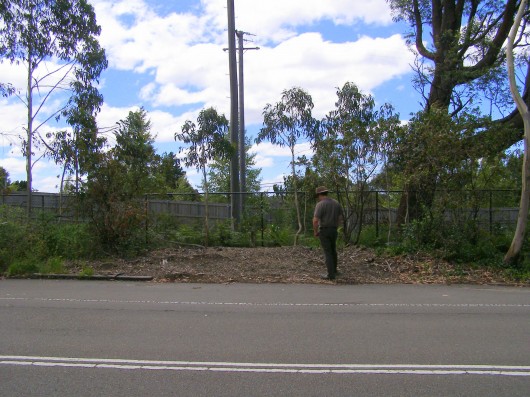 #5 Blue Mountains Ash
(Eucalyptus oreades) #5 Blue Mountains Ash
(Eucalyptus oreades)
(Opposite 252 Old Bathurst Rd. Katoomba Opposite Lot 2 DP707, listed 6.5.84, since chainsawed)
.
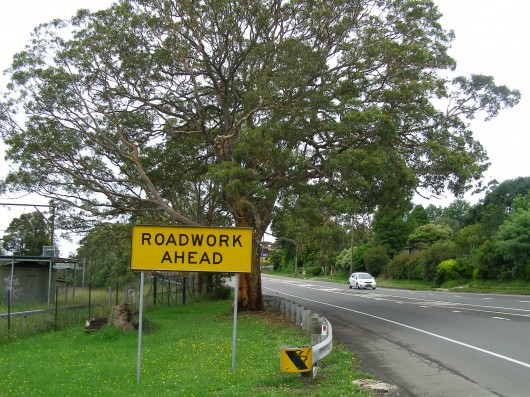 #29 Smooth Barked Apple, Red Gum
(Angophora costata)
(Opposite 363 Great Western Highway, Bullaburra, opposite Lot 173, DP13407, Listed 17.7.85,
condemned by the Roads & Traffic Authority in September 2008 to widen the highway into a 4 laned Trucking Expressway) #29 Smooth Barked Apple, Red Gum
(Angophora costata)
(Opposite 363 Great Western Highway, Bullaburra, opposite Lot 173, DP13407, Listed 17.7.85,
condemned by the Roads & Traffic Authority in September 2008 to widen the highway into a 4 laned Trucking Expressway)
.
New South Wales Government sentence imposed upon this Angophora:
.
“The Angophora (Sydney red gum) tree: the large tree is situated to the east of Boronia Road.
To retain the Angophora tree the highway would have to be widened either towards the railway line or the private properties. In both cases, land would have to be acquired, either from RailCorp or private land owners. The tree’s overhanging branches would have to be trimmed and there would be construction activities around the tree.
Arborist advice is that the consequent loss of tree roots and the pruning would instigate the decline of the tree. Angophora are highly sensitive to construction impacts such as changes to draining patterns and soil compaction. For road construction and safety reasons the tree will have to be removed.”
[Source: ‘Great Western Highway Upgrade – Community Update September 2008, ‘Bullaburra East – Ridge Street, Lawson to Genevieve Road Bullaburra, by Roads and Traffic Authority]
.
Ed: Well, humans can find ways of justifying anything when it suits them – ecological destruction, genocide, wars, anything. Governments and road making organisations like the RTA are collectives of people with mandates that are self-serving.
The RTA (since rebranded) does not have to widen the highway through Bullaburra. It is only doing so to encourage greater truck and car traffic and so that such road traffic can flow faster. Bigger and more roads is the mandate for this road maker. The tradition of slowing down through local towns and villages has been dismissed. Utilitarian convenience is supplanting local rights and values. Other options have been deliberately ignored such as upgrading rail freight logistics and public transport (the rail runs adjacent to and follows the same route as this highway). Land acquistion is an easy process for the RTA. It’s management is just choosing not to take this option because it sees no value in the tree nor in Bullaburra’s amenity.
The tree’s overhanging branches would not have to be trimmed and construction activities could be well away from the tree, if the RTA management so choosed.
The RTA’s standard justification “safety reasons” had to be the clincher. the RTA relies on the ‘safety justification’ as its fallback to get its way, because it has convinced that no-one can reasonably challenge such a justification. That the M4 Motorway with its six lanes has become one of the most deadly RTA roads in New South Wales does not seem to trouble the RTA sufficiently to invest in making the M4 safer. The RTA is hypocritical about road safety.
The value of encouraging faster and bigger trucks and more cars to race through Bullaburra at 80+kph is more important to it than conserving some tree. That this particular tree has been dated by a specialist arborist as being older than300 years and so would have stood when the Three Explorers first crossed the Blue Mountains in 1813, is dismissed as worthless by the RTA and the New South Wales Government. Labor and Liberal are no different in this world view of ‘progress’. Bullaburra is set to be transformed into a Blaxland with bigger trucks racing through it. Bullaburra will become even more divided that what it is now.
If this tree were a war cemetery, there is no question that the cemetery value would be respected and a trucking expressway would not be carved through it.
.
 Les Wielinga
NSW Roads and Traffic Authority Chief (2006-2012)
Executioner of Bullaburra’s Angophora
and Strategic Planner of the Trucking Expressway juggernaut through the Blue Mountains Les Wielinga
NSW Roads and Traffic Authority Chief (2006-2012)
Executioner of Bullaburra’s Angophora
and Strategic Planner of the Trucking Expressway juggernaut through the Blue Mountains
.
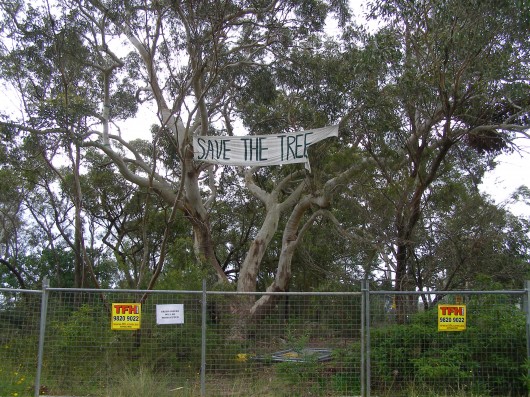 #33 Scribbly Gum
(Eucalyptus sclerophylla/Eucalyptus piperita hybrid)
(Cnr St Georges Cres. & Adeline St. Faulconbridge, Lot 5 DP8526 , Listed 24.8.85,
condemned in Sep 2011 for selfish dual occupancy housing development) #33 Scribbly Gum
(Eucalyptus sclerophylla/Eucalyptus piperita hybrid)
(Cnr St Georges Cres. & Adeline St. Faulconbridge, Lot 5 DP8526 , Listed 24.8.85,
condemned in Sep 2011 for selfish dual occupancy housing development)
.
Blue Mountains Council arborist has condemned the tree as having ‘extensive decay’.
.
Trial by Ordeal?
.
Local residents protesting to save the tree, believe this native Scribbly Gum to be quite healthy and that the arborist’s so-called ‘decay‘ is in fact a natural fungus. The residents believe that Council’s arborist’s assessment has incorrectly condemned the tree and that only after the tree trunk is chainsawed will the proof of the tree’s health be revealed.
It will be akin to being a Medieval Trial by Ordeal imposed on those suspected of being a witch. An example is where a priest would demand a suspect to place his hand in the boiling water. If after three days, God had not healed his wounds, the suspect was guilty of the crime.
In the case of this Scribbly Gum, if after chainsawing it, the trunk shows no signs of internal decay, then it can be confirmed as having being healthy, but by then it will be dead.
.
The Council’s assessment:
“It should also be noted that the significant tree has been assessed as not being viable for retention in any case as the result of extensive decay throughout the trunk. This matter is discussed in more detail in the body of the report.”
[Source: Blue Mountain Council, Business Paper, Using Land for Living Item 20, Ordinary Meeting, 20110628, Development Application No. X/443/2010 for a detached dual occupancyconsisting of a singe storey dwelling and a two storey dwelling on Lot 5 SEC. 2 DP 8526, 47 St Georges Crescent, Faulconbridge, File No: F06738 – X/443/2010 – 11/85977, Clause 44, p.214]
.
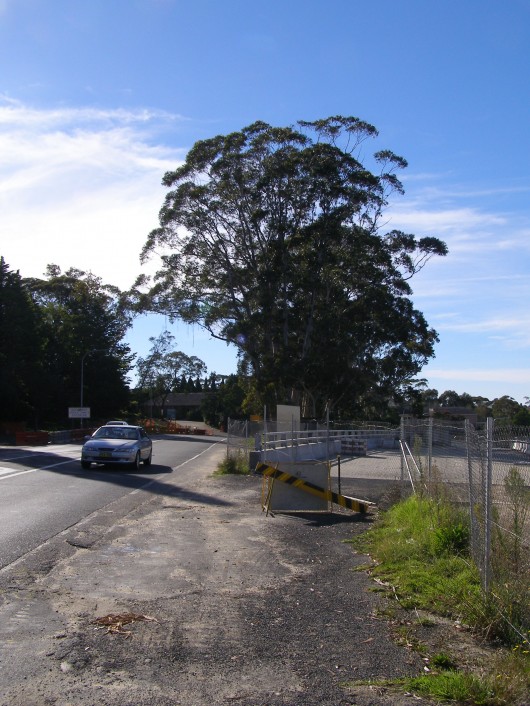 #61 Blue Mountains Ash #61 Blue Mountains Ash
(Eucalyptus oreades – once was a ridgetop forest)
(Railway Reserve opposite Katoomba Hospital, Listed 6.11.89,
half the trees chainsawed in 2008 to widen the highway into a Trucking Expressway.
What’s left is a token coppice so that the RTA can claim on paper that it respected the ‘significant’ status.)
.
Relevance and future of the Significant Tree Register
.
In November 2011, Blue Mountains Councillor Janet Mays presented a Notice of Motion to Council:
.
“That the Council receives a report detailing the role and relevance of Council’s Significant Tree Register, including the cost of both managing and maintaining that Register.”
Background
The recent decision by the Land & Environment Court, to uphold an appeal by the applicants at 47 St Georges Crescent, Faulconbridge, includes permission to remove a tree that is listed on Council’s Significant Tree Register that decision brings into question the relevance of this Register.
The report should outline the role and relevance of the Register in providing decision-making capability to Council’s Planning Officers. The role and relevance of the Register should then be considered in terms of benefits and cost of maintaining this Register. Dependant on the benefits and the costs, the future utility of the Register should also be discussed.”
[Source: Blue Mountains Council, Business Paper, Notices of Motion, Item 26, Ordinary Meeting, 20111122, Subject: Council’s Significant Tree Register, File No: F06745 – 11/178956, p.173]
.
Ed: Meanwhile, anthropocentric prejudice sees the National Trust of Australia (an organisation supposedly committed to promoting and conserving Australia’s indigenous, natural and historic heritage) recognise people as ‘National Living Treasures’. No thought is given to Australian native trees, many which have stood longer than any colonist set foot on Australian soil. Surely, a 300+ year old native tree has more claim to being a national living treasure.
On 4 March 2012, two days ago, we hear that Queensland mining magnate Clive Palmer has been named a National Living Treasure. Palmer has made is fortune exploiting Australia’s landscape for his personal gain. Clearly, Australian Governments continued to be dominated by 20th Century Baby Boomer exploitative world views.
.
Further Reading
.
[1] Blue Mountains Council Register of Significant Trees (1988), ^ http://www.bmcc.nsw.gov.au/download.cfm?f=28AD1E14-423B-CE58-AD64F47560FC3345, [ Read Register]
.
Tags: Angophora, Blue Mountains, Blue Mountains Ash, Blue Mountains Council, Blue Mountains Significant Tree Register, Bullaburra, Eucalyptus oreades, Great Western Highway, National Living Treasure, Scribbly Gum
Posted in Blue Mountains (AU), Threats from Development, Threats from Greenwashing, Threats from Road Making | 2 Comments »
Add this post to Del.icio.us - Digg
Monday, January 16th, 2012
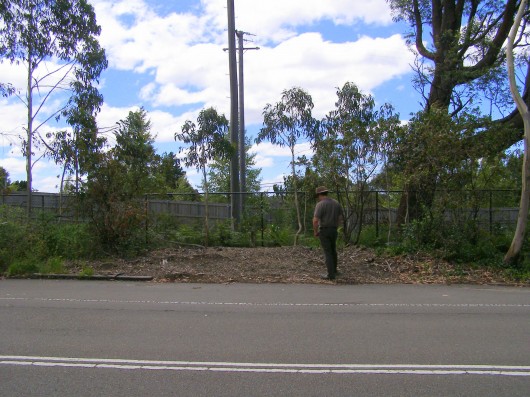 The site of Blue Mountains Significant Tree #5 – it was a massive Eucalyptus oreades
~ Our endemic heritage woodchipped into oblivion
Lest we forget!
(Photo of Editor 20120111, free in public domain, click photo to enlarge) The site of Blue Mountains Significant Tree #5 – it was a massive Eucalyptus oreades
~ Our endemic heritage woodchipped into oblivion
Lest we forget!
(Photo of Editor 20120111, free in public domain, click photo to enlarge)
.
This mature native tree was respected enough to have been listed on Blue Mountain Council’s Significant Tree Register. Indeed it was the 5th such listed tree on Blue Mountains Council’s Register of Significant Trees back in 1988.
So what is the meaning of a ‘Significant Tree‘ on Blue Mountains Council’s register?
Well back on 21st June 1988 the Register of Significant Trees was adopted by Blue Mountains Council as an integral part of its Development Control Plan, which proclaimed significant trees be protected under Clause 6 ‘Protection of Items Listed in the Register of Significant Trees‘ so that:
.
‘No person shall ringbark, cut down, top, lop, injure, wilfully destroy or cause damage to the root system off any tree listed on the Register of Significant trees without consent of Council.’
.
Perhaps the current Blue Mountains Council mayor may care to publicly explain why its Significant Tree Number 5, a locally endemic Eucalyptus oreades (Blue Mountains Ash) of some stature located opposite 252 Old Bathurst Road Katoomba (Lot 2 DP707) has been woodchipped into oblivion?
- Was formal Blue Mountains Council consent given to kill it?
- If so, when was this Blue Mountains Council consent given to kill it?
- What Blue Mountains Council documentation is publicly available to validate such consent?
- What public notice was provided by Blue Mountains Council for community consultation about its killing?
- Does Blue Mountains Council give a bleeding toss?
.
The objectives of Blue Mountains Council’s Significant Tree Register include:
.
(a) identify and protect those trees listed on the Register
(b) promote greater public awareness of the existence of the Register, and the individual items listed
(c) ensure existing and, importantly, prospective land owners, are made aware of the Significant Trees which may be located on their property
(d) ensure correct on-going care and maintenance of those trees listed, through the recommendations included with the significant tree register
.
The following tree is not even on the Blue Mountains Council Significant Tree Register, so has even less chance of protection.
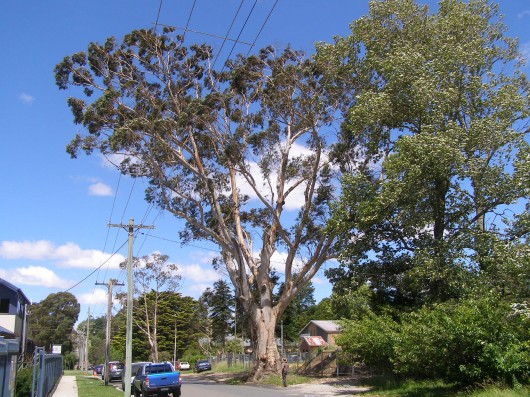 Katoomba’s most significant (grandfather) Eucalyptus oreades, beside Megalong Street
Pitifully it manages to survive as an extremely rare relic of the once magnificent Oreades Forest
This tree is ‘endemic’ to the Central Upper Blue Mountains at Katoomba
(That is, it grows naturally nowhere else on the friggin Planet!)
(Photo of Editor 20120111, free in public domain, click photo to enlarge) Katoomba’s most significant (grandfather) Eucalyptus oreades, beside Megalong Street
Pitifully it manages to survive as an extremely rare relic of the once magnificent Oreades Forest
This tree is ‘endemic’ to the Central Upper Blue Mountains at Katoomba
(That is, it grows naturally nowhere else on the friggin Planet!)
(Photo of Editor 20120111, free in public domain, click photo to enlarge)
.
But this tree is perpetually being subjected by Blue Mountains Council approved industrial development after industrial development – the road widening, the recent expansion of the bus depot across the road and now some ‘mega industrial’ estate behind it. Blue Mountains Council pro-development forces are mounting against it.
.
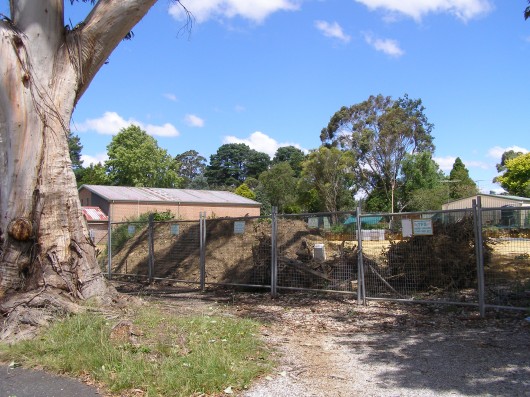 The Mega industrial development immediately behind this magnificent native tree
~ but what would BMCC care?
(Photo by Habitat Investigator 20120111, free in public domain, click photo to enlarge) The Mega industrial development immediately behind this magnificent native tree
~ but what would BMCC care?
(Photo by Habitat Investigator 20120111, free in public domain, click photo to enlarge)
.
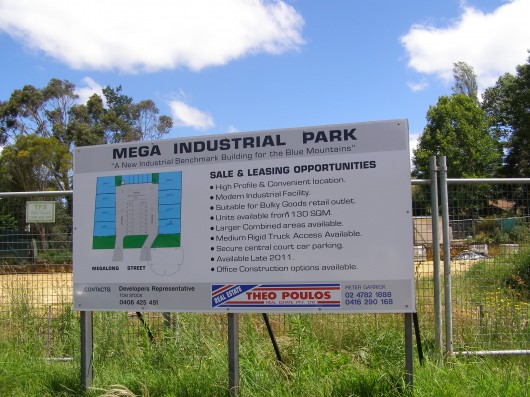 The Theo Poulos promoted ‘Mega Industrial Park’
excavated right behind this rare, significant Eucalyptus oreades,
~ as if the developer or Theo Poulos gives a crap!
(Photo by Habitat Investigator 20120111, free in public domain, click photo to enlarge) The Theo Poulos promoted ‘Mega Industrial Park’
excavated right behind this rare, significant Eucalyptus oreades,
~ as if the developer or Theo Poulos gives a crap!
(Photo by Habitat Investigator 20120111, free in public domain, click photo to enlarge)
.
But then Blue Mountains Council’s so-called Significant Tree Register has always been a crock of deceptive community greenwashing!
As soon as any tree on its register becomes slightly inconvenient, our pro-development Blue Mountains Council, strangled by Liberal-Labor Party vested interests, easily turns a blind eye to significant Blue Mountain heritage and no more significant tree.
Is it any wonder that as the Blue Mountains is allowed to be developed and its natural amenity destroyed that outsiders no longer see the Blue Mountains as a significant attraction, but more as an extension of Sydney sprawl? They just speed past on that forever faster, noisier and more dangerous Trucking Expressway!
.
Tags: Blue Mountains, Blue Mountains City Council, Blue Mountains Council, Blue Mountains Significant Tree Register, Blue Mountains World Heritage Area, endemic, Eucalyptus oreades, industrial development, Lest we forget, Megalong Street, Oreades Forest, significant trees
Posted in Blue Mountains (AU), Threats from Development, Threats from Greenwashing | 1 Comment »
Add this post to Del.icio.us - Digg
Tuesday, January 3rd, 2012
[The following article was initially published as a letter in the local Blue Mountains Gazette (BMG) newspaper on page 4 by this Editor 20081008 under the title ‘RTA Juggernaut‘. It was sparked by reading two separate letters in the paper from Bullaburra residents angry with the RTA and the highway widening process. Copies of those letters are at the end of this article – one by long time Bullaburra resident Viki Wright Rivett; the other by lifetime Bullaburra resident and local historian Una King.]
.
Note: RTA = New South Wales Roads and Traffic Authority; GWH = Great Western Highway
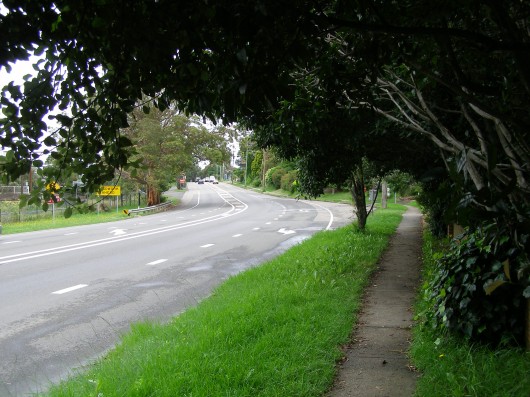 Bullaburra’s rural amenity
Looking east along Great Western Highway towards Railway Station (left)
(Photo by Editor 20110115, free in public domain, click photo to enlarge) Bullaburra’s rural amenity
Looking east along Great Western Highway towards Railway Station (left)
(Photo by Editor 20110115, free in public domain, click photo to enlarge)
.
Decades of complacency and naivety, or do residents of bucolic Bullaburra simply deserve rights to quiet enjoyment and their buena vista? The RTA highway juggernaut is at the door. It won’t just ‘bisect’ the community [‘Anger at RTA‘ BMG 1-10-08]; it will permanently segregate it, raze its rural amenity and degrade it into a noisy truck side stop. Bullaburra is set to receive the same utility vision imposed on Blaxland and so many other Mountains communities.
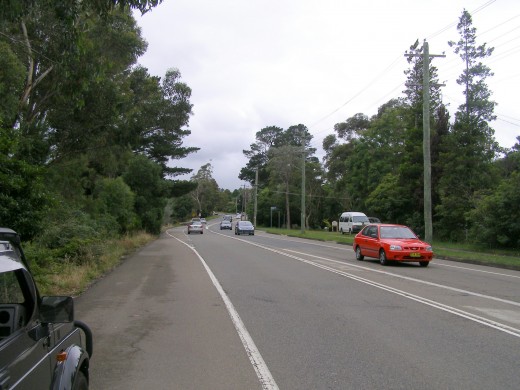 Bullaburra looking east along Great Western Highway towards Noble Street (far centre)
(Photo by Editor 20110115, free in public domain, click photo to enlarge) Bullaburra looking east along Great Western Highway towards Noble Street (far centre)
(Photo by Editor 20110115, free in public domain, click photo to enlarge)
.
I too attended the August township meeting at Bullaburra’s Progress Association hall, not as a Bullaburra resident, nonetheless as a Mountains resident. At the packed meeting, Bullaburrans unanimously endorsed an alternative plan asking the RTA to accommodate local linkages across what will become another four-lane barrier dividing a local community. Personal experience in dealing with the RTA at Leura, Medlow Bath and Katoomba affirms it doesn’t listen or care. It has just plundered the rare 1820s convict road at Leura, hardly pausing its schedule.
 Bullaburra: “Blue Skies” Village – reads the sign (Aboriginal translation)
Western approach to Bullaburra along the Great Western Highway
(Photo by Editor 20110115, free in public domain, click photo to enlarge)
Bullaburra: “Blue Skies” Village – reads the sign (Aboriginal translation)
Western approach to Bullaburra along the Great Western Highway
(Photo by Editor 20110115, free in public domain, click photo to enlarge)
.
The RTA’s massive budget is only limited by political will. It stands to be key recipient of the new Building Australia Fund of $22,000,000,000 then claims it can’t afford community bridges. Be clear, the RTA’s mandate for ‘progress’ is to build more expressways. Driven by road lobbyists, the RTA is extending greater Sydney’s swelling suburbia like Roman legions extended empire.
‘Few understand how much transport influences land use patterns. Transport leads land use. Once an expressway or railway is built, it is easy to change the zoning and development laws to increase the population along the corridor.’ [Then NSW Minister for Planning, Frank Sartor, SMH 29-9-08, p11].
RTA performance is measured by it maximising road ‘ride quality’ and minimising ‘travel times.’ The RTA juggernaut will remain unstoppable so long as local townships rely upon single-handed last ditch battles. Our freshly elected Mountains councillors should stand up for the people of Bullaburra.
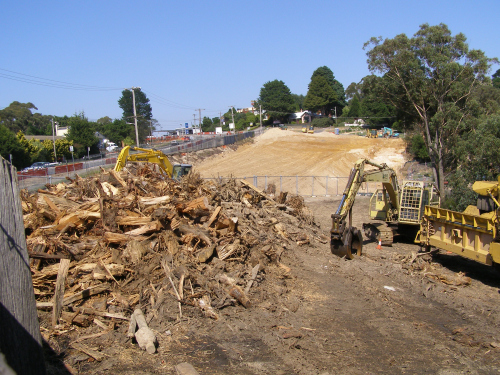 This is what awaits Bullaburra – destruction of rural amenity This is what awaits Bullaburra – destruction of rural amenity
Clearfelled mature native trees at Katoomba to make way for a wider faster trucking expressway
Same project, different section.
(Photo by Editor 20090501, free in public domain)
.
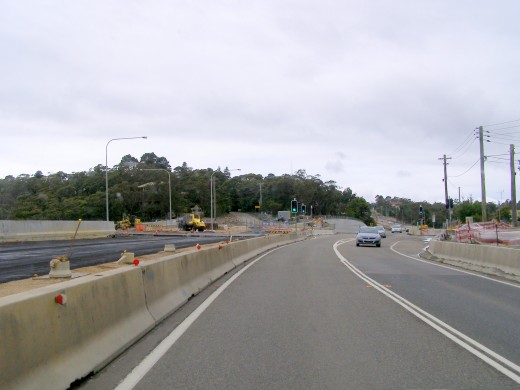 More of what awaits Bullaburra – a trucking expressway amenity! More of what awaits Bullaburra – a trucking expressway amenity!
Eastern approach to Wentworth Falls near Rest Easy Motel (off photo to right).
(Photo by Editor 20110115, free in public domain, click photo to enlarge).
.
.
Following this letter in the weekly local paper, the next week (20081015) the Chairman of the Bullaburra Township Committee, Mr Will Silk, responded as follows:
.
‘Missed Target’
letter by Will Silk in BMG 20081015
.
‘I really don’t know where the author (BMG 08.Oct.2008) is coming from, but he seems to have parachuted into a campaign in the dark and has missed the landing zone.
Steven, a word, to you and other latecomers who are just now arriving from above to hitch themselves to the Bullaburra bandwagon – take the time to find out more about us partisans and the grounds on which we have to work.
At the recent Bullaburra Town Meeting, if you weren’t so blinkered by your condescending stereotyping of a “bucolic Bullaburra”, with its residents slumbering in selfish “complacency and naivety”, you might have seen, heard and, possibly, learned some things of interest to residents’ right activists, environmentalists and radical democrats.
You correctly observed a packed meeting of Bullaburra residents as they unanimously (re-)endorsed the Bullaburra Township Committee’s (BTC) plan to manage the way in which the GWH goes through Bullaburra, and condemned the RTA’s plan.
But, hey, Steven! Where did the BTC Plan come from? It came from 18 years’ proactive work by Bullaburra residents and their organisations. We saw the RTA “juggernaut” coming a long time ago, and instead of just whingeing, we developed our own plan before the RTA did, and we united behind it!
You failed to see that at the meeting, the BTC Plan (with its three integral foundations of pedestrian trian bridge), service road and North-South Bullaburra road-rail bridge) has the unanimous support of all the community organisations in Bullaburra. You also failed to hear all of the now elected ward councillors give our plan their support. And moreover, you didn’t see the now mayor, Adam Searle, and from the Liberal side, Chris van der Kley both, literally “stand up”, together and not for the first time, to show their support.
Far from being naive and complacent, Bullaburra, and the BTC have already put in the hard yards of “politically correct” struggle; delegations, submissions, lobbying. What you failed to see at the meeting was a community gearing up, giving its representatives a very clear mandate, for the next stage in its struggle for a renewed, people and environmentally-friendly village.
We are not “at a last ditch”. But we are about to go to the barricades. We encourage you and all Blue Mountaineers who care about creating such townships to join us if you wish. But leave the mocking paternalism behind. Seeing the RTA as an “instoppable Juggernaut” is defeatist. It is a sort of jaded fatalism that is itself an impotent form of complacency.’
~ Will Silk, President of the Bullaburra Township Committee.
.
.
Harsh defensive words from Mr Silk.
I chose not to reply to Will Silk’s above letter in the local paper, because to have done so would have only detracted Bullaburra residents from their united focus behind Will Silk to deal with the RTA. The aim of my letter had merely been to awaken fence sitting residents to the realisation of the force and power they were dealing with at the RTA. I had witnessed similar David v Goliath community campaigns along the highway, most notably at adjacent Lawson, each village/town community singularly convinced that their case was special and naively campaigning in isolation against the legal might and finances of the RTA.
So I was happy to withdraw my involvement at the time to avoid potential conflict, yet my protest campaign in the local paper broadly against the Trucking Expressway continued through into 2010.
What Mr Silk didn’t realise was that I had been actively involved in previous community campaigns concerning the RTA highway widening stretching back to 2001 when I first arrived in the Blue Mountains. Previous highway campaigns have included Shell Corner (2001-02), Soldiers Pinch (2001-02), Lawson (2003-09), Leura section 1 (2004-05), Medlow Bath (2005 ), Leura section 2 (2006-08), Katoomba (2006-09), Mount Victoria bypass (2006-08) and Bells Line of Road (2005-07).
What Mr Silk also didn’t realise was that at the time I was contracting as a management accountant with the RTA, with some insight into the mechanisations, agendas and management culture of this very much political organisation. What Mr Silk also didn’t realise was that I had researched the history of Bullburra and learnt about the RTA plans for the highway widening through the town.
The RTA plans are set to divide Bullaburra by a faster four-laned expressway, greatly restricting local access and offering very few design concessions to local residents.
.
.
I didn’t have to wait long for the optimistic Bullaburra community sentiments to sour about the likely success of the BTC’s alternative highway design.
The above letter in the local paper by Mr Silk a Chairman of the Bullaburra Township Committee, saw the following week a media release by the Bullaburra Township Committee, headed up with a photo including Will Silk.
.
‘Bullaburra joins highway battle‘
by Michael Cleggett (journalist), BMG 20081022, p3.
.

‘The RTA’s highway-widening roadshow continues to attract jeers wherever it arrives, and this time it’s Bullaburra residents voicing anger at plans for their stretch of tarmac.
Members of the Bullaburra Township Committee (BTC) are furious their own designs for the upgrade have seemingly been ignored.
BTC president Will Silk is concerned the RTA has not fully accounted for the effect of any works on the village and its people.
After years of campaigning to different levels of government and departments, residents were dismayed by the RTA proposal when it was made public earlier this year.
“We went in to see them in the first week of June this year and not to our surprise, but to our disgust, we found that they didn’t even know about our plan, they hadn’t taken it into consideration,” Mr Silk said.
In anticipation of the highway upgrade the community has been looking into the issue for more than 20 years. The three pillars of the BTC designs are a road bridge connecting north and south Bullaburra, a comprehensive service road on the southern side running parallel to the highway and a pedestrian bridge. None of these form part of the RTA’s proposal.
Mr Silk said the BTC’s vision presents a much better opportunity to create “a modern 21st century village with the unavoidable highway through the middle of it”.
The service road is intended to allow residents to traverse the town without having to make a difficult turn onto the highway while the bridges would avoid permanently dividing the town as well as providing easier emergency vehicle access. This stage of work will expand the highway to two lanes in each direction from Noble Street to 600 metres west of Genevieve Road.
Outside of the widening, the main features of the RTA plans involve relocating the commuter car park to the southern side of the highway, moving the pedestrian crossing lights, an access road for some properties between Genevieve Road and Noble Street and a number of other changes to street access and bus stops.
Member for Blue Mountains Phil Koperberg has expressed a willingness to further examine the issue.
“(The BTC) proposal for a link bridge between north and south of the Great Western Highway obviously has merit,” he said. “However, whether or not it is practical, feasible or constructable I’ll take advice from the RTA.”
An RTA pamphlet delivered to residents suggests that advice will be bad news. It describes a comprehensive access road and a pedestrian overbridge as unfeasible.
A spokesperson for the RTA said an information session earlier this month was well attended with “some worthwhile suggestions . . . put forward, which will be investigated”.
A second information session will be held by the RTA from 10am-1pm at Lawson Bowling Club this Saturday, October 25.’
.
.
This article by the Bullaburra Township Committee was then followed up by Bullaburra resident Patrick Tatam, who clearly had a stronger interpretation of how discussions between locals and the Roads and Traffic Association were proceeding.
.
‘RTA Bullaburra fiasco’
by Patrick Tatam, Bullaburra (letter in BMG 20081029, p4)
.
‘Regarding the obstructionist, bullying attitude of the RTA towards the Bullaburra Township Committee (BTC), attacking the BTC’s proposed alternativeplan for the GWH rod widening through Bullaburra, here’s my take on what locals are saying:
- The major political parties are basically inept, unable to listen to constituents and consumed with retaining/grasping power
- Phil Koperberg (then local Labor MP) has no effectively influential power, says anything to avoid an issue, is “a bit of a show pony”, and has furthered his career utilising the ‘who you know, not what you know’ approach
- The RTA is seen as a mob of bureaucratic bullies, are even more incompetent than their political masters (the Hazelbrook railway bridge fiasco is common knowledge), and are responsible/answerable solely to the faceless bosses located deeply within the termite mound of RTA headquarters.
- RTA representatives at community meetings are aggressive, non-consultative, driven only by their own preferred agendas, ill-prepared, and are the antithesis of ‘public servants’
- Exiting either Boronia or Genevieve Road is currently dangerous, and will become definitely more so with the planned RTA ‘seagull’ intersection, increased speed restrictions (from 70kph to 80kph) and higher traffic volumes (particularly those larger faster trucks).
- The BTC’s plan is a far better solution for the Bullaburra area than the ‘crash through or crash anyway’ RTA proposal; it’s a plan that addresses the needs of the people who live here, not the needs of a termite from a city office, and incorporates beneficial infrastructurec, not just ‘bloody minded’ bitumen.
.
Elected government members, and RTA personnel, should realise that they are our representatives, and that locals are becoming more politically astute, voting more for independents, if only to make our representatives more representative. Those bullies that remain, hiding behind the skirts of party machinery, should recall the destiny of the dinosaur. Or just move to the last bastions of ‘Bullyville’: Zimbabwe, Myanmar, etc.
~Patrick Tatam, Bullaburra.
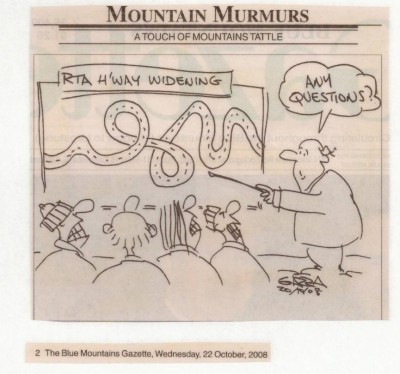
.
.
Editor’s Campaign to Save Bullaburra’s 300+ year old Angophora tree from the RTA
.
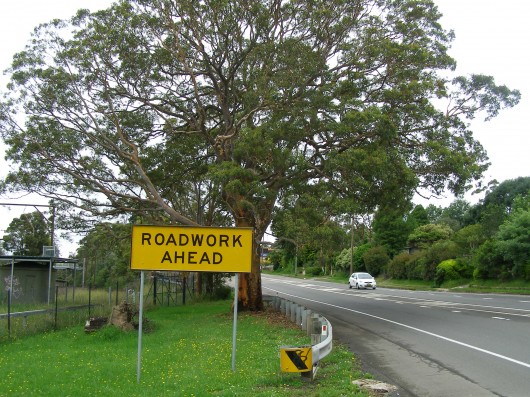 Bullaburra’s Angophora – on RTA’s death row Bullaburra’s Angophora – on RTA’s death row
.
Listed on Blue Mountains Council’s Significant Tree Register
Registered Significant Tree #: 29
Botanical Name: Angophora costata
Common Name: Smooth Barked Apple, Red Gum
Date Registered: 17th July 1985, adopted 21st June 1988
Location: Great Western Highway, Bullaburra, Opp. Lot 173, DP13407.
[Read Significant Tree Register]
.
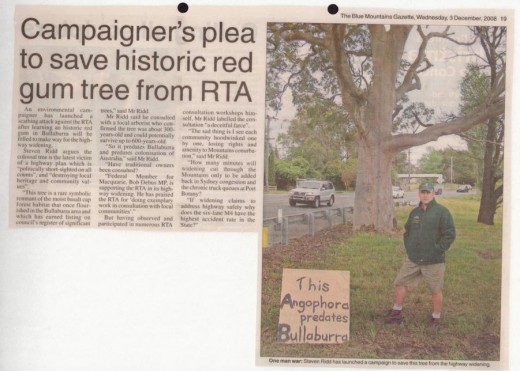 Campaign article in Blue Mountains Gazette 20081203, p19.
.
This followed a quarter page campaign article published in this newpaper on 20081105 costing this Editor $460.
(Click image to enlarge) Campaign article in Blue Mountains Gazette 20081203, p19.
.
This followed a quarter page campaign article published in this newpaper on 20081105 costing this Editor $460.
(Click image to enlarge)
.
.
Letters by Bullaburra residents 20081001
.
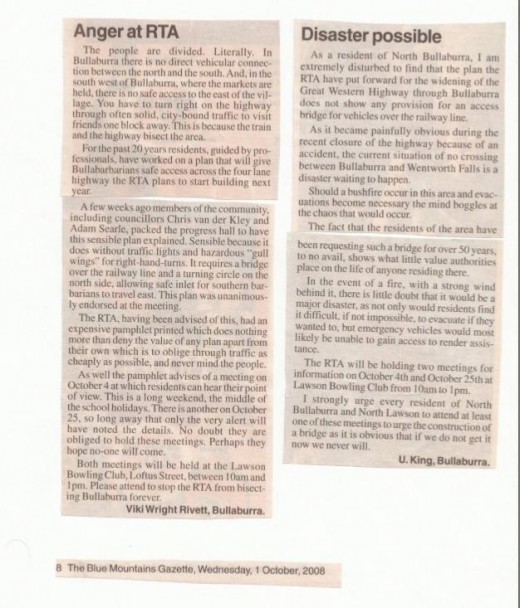 (Click image to enlarge) (Click image to enlarge)
.
|
|






































